
Sri Lanka’s healthcare system is under increasing pressure as rising patient volumes and limited resources challenge hospitals and medical staff nationwide. Officials warn that without urgent investment in infrastructure and personnel, the sector may struggle to meet the growing demand for quality medical services.
The country’s population growth, coupled with the prevalence of chronic diseases and the lingering effects of past health crises, has placed a significant burden on hospitals and clinics. Many healthcare facilities are operating beyond capacity, leading to longer wait times, staff burnout, and reduced quality of patient care.
According to recent reports:
Hospitals in both urban and rural areas are experiencing record patient admissions, especially in general medicine, emergency care, and maternal health services.
Overburdened medical personnel are struggling to maintain adequate care standards, with nurses and doctors facing extended shifts and limited resources.
Medical equipment shortages and aging hospital infrastructure have further exacerbated operational challenges.
Health ministry officials are advocating for increased government funding, enhanced recruitment of healthcare professionals, and expansion of hospital facilities to address current and future demand.
Experts stress that improving primary healthcare networks, upgrading technology, and expanding rural medical access are crucial steps to prevent systemic collapse and ensure equitable healthcare provision.
Private healthcare providers are also experiencing higher patient numbers, highlighting the overall strain on the country’s health system. Some hospitals have started digital appointment systems to streamline patient flow, while community-based health programs are being encouraged to reduce pressure on central facilities.
International health organizations have offered technical support and training programs to assist Sri Lanka in optimizing resource allocation and strengthening emergency preparedness.
Sri Lanka’s healthcare sector is at a critical juncture, facing mounting demand and limited capacity. Strategic investments in infrastructure, workforce, and technology are essential to ensure that citizens receive timely and quality medical care. Addressing these challenges is vital for the long-term resilience of the nation’s healthcare system.

Comments: